3. Dutta AK, Aggarwal A. Newer development in immunization practices. Indian J Pediatr. 2018; 01. 85(1):44–46. DOI:
10.1007/s12098-017-2530-y.

4. National Health Mission, Government of India. About NHM [Internet]. [place unknown]: National Health Mission, Government of India;c2014. cited 2018 Jun 15. Available from:
http://nhm.gov.in/nhm/about-nhm.html.
5. Sidney K, Diwan V, El-Khatib Z, de Costa A. India's JSY cash transfer program for maternal health: Who participates and who doesn't-a report from Ujjain district. Reprod Health. 2012; 01. 24. 9:2. DOI:
10.1186/1742-4755-9-2.

6. Lim SS, Dandona L, Hoisington JA, James SL, Hogan MC, Gakidou E. India's Janani Suraksha Yojana, a conditional cash transfer programme to increase births in health facilities: an impact evaluation. Lancet. 2010; 06. 375(9730):2009–2023. DOI:
10.1016/S0140-6736(10)60744-1.

7. Barros AJ, Victora CG. Measuring coverage in MNCH: determining and interpreting inequalities in coverage of maternal, newborn, and child health interventions. PLoS Med. 2013; 10(5):e1001390. DOI:
10.1371/journal.pmed.1001390.

8. Corsi DJ, Subramanian SV. Association between coverage of maternal and child health interventions, and under-5 mortality: a repeated cross-sectional analysis of 35 sub-Saharan African countries. Glob Health Action. 2014; 09. 03. 7:24765. DOI:
10.3402/gha.v7.24765.

9. Kruk ME, Freedman LP. Assessing health system performance in developing countries: a review of the literature. Health Policy. 2008; 03. 85(3):263–276. DOI:
10.1016/j.healthpol.2007.09.003.

11. Lincetto O, Mothebesoane-Anoh S, Gomez P, Munjanja S. Chapter 2, Antenatal care. In : Lawn J, Kerber K, editors. Opportunities for Africa's newborns: practical data, policy and programmatic support for newborn care in Africa. [Geneva (Switzerland)]: World Health Organization;2006. p. 51–62. Available from:
http://www.who.int/pmnch/media/publications/oanfullreport.pdf.
12. Gupta A, Fledderjohann J, Reddy H, Raman VR, Stuckler D, Vellakkal S. Barriers and prospects of India's conditional cash transfer program to promote institutional delivery care: a qualitative analysis of the supply-side perspectives. BMC Health Serv Res. 2018; 01. 25. 18:40. DOI:
10.1186/s12913-018-2849-8.

16. Das J, Hammer J, Leonard K. The quality of medical advice in low-income countries. J Econ Perspect. 2008; 22(2):91–116. Spr. DOI:
10.1257/jep.22.2.93.

17. Chaudhury N, Hammer J, Kremer M, Muralidharan K, Rogers FH. Missing in action: teacher and health worker absence in developing countries. J Econ Perspect. 2006; 20(1):91–116. DOI:
10.1257/089533006776526058.

18. Carroli G, Rooney C, Villar J. How effective is antenatal care in preventing maternal mortality and serious morbidity? An overview of the evidence. Paediatr Perinat Epidemiol. 2001; 15:Suppl 1. 1–42. DOI:
10.1046/j.1365-3016.2001.0150s1001.x.

19. Bhutta ZA. Mapping the geography of child mortality: a key step in addressing disparities. Lancet Glob Health. 2016; 12. 4(12):e877–e878. DOI:
10.1016/S2214-109X(16)30264-9.

20. Singh A, Pathak PK, Chauhan RK, Pan W. Infant and child mortality in India in the last two decades: a geospatial analysis. PLoS One. 2011; 6(11):e26856. DOI:
10.1371/journal.pone.0026856.

21. Raven JH, Tolhurst RJ, Tang S, Van Den Broek N. What is quality in maternal and neonatal health care? Midwifery. 2012; 10. 28(5):e676–e683. DOI:
10.1016/j.midw.2011.09.003.

22. Dettrick Z, Gouda HN, Hodge A, Jimenez-Soto E. Measuring quality of maternal and newborn care in developing countries using demographic and health surveys. PLoS One. 2016; 06. 11(6):e0157110.

23. Kozhimannil KB, Hung P, Prasad S, Casey M, McClellan M, Moscovice IS. Birth volume and the quality of obstetric care in rural hospitals. J Rural Health. 2014; 30(4):335–343. Fall. DOI:
10.1111/jrh.12061.

24. Pileggi-Castro C, Camelo J Jr, Perdonaá G, Mussi-Pinhata MM, Cecatti JG, Mori R, et al. Development of criteria for identifying neonatal near-miss cases: analysis of two WHO multicountry cross-sectional studies. BJOG. 2014; 03. 121:Suppl 1. 110–118. DOI:
10.1111/1471-0528.12637.

26. National Family Health Survey. NFHS-4 [Internet]. Maharashtra: International Institute for Population Sciences;c2009. cited 2018 Jan. Available from:
http://rchiips.org/NFHS/nfhs4.shtml.
27. Subramanian SV, Glymour MM, Kawachi I. Chapter 15, Identifying causal ecologic effects on health: a methodologic assessment. Macrosocial determinants of population health. New York: Springer;2007. p. 301–331.
28. Kim R, Mohanty SK, Subramanian SV. Multilevel geographies of poverty in India. World Dev. 2016; 11. 87:349–359. DOI:
10.1016/j.worlddev.2016.07.001.

29. Subramanian SV, Jones K, Duncan C. 4. Multilevel methods for public health research. Neighborhoods and health. New York: Oxford University Press;2003. p. 65–111.
30. Goldstein H. Multilevel statistical models. 4th ed. West Sussex: John Wiley & Sons;2011. p. 382.
31. Ejigu Tafere T, Afework MF, Yalew AW. Antenatal care service quality increases the odds of utilizing institutional delivery in Bahir Dar city administration, north western Ethiopia: a prospective follow up study. PLoS One. 2018; 02. 08. 13(2):e0192428. DOI:
10.1371/journal.pone.0192428.

32. Ram F, Singh A. Is antenatal care effective in improving maternal health in rural Uttar Pradesh? Evidence from a district level household survey. J Biosoc Sci. 2006; 07. 38(4):433–448. DOI:
10.1017/S0021932005026453.

33. Bloom SS, Lippeveld T, Wypij D. Does antenatal care make a difference to safe delivery? A study in urban Uttar Pradesh, India. Health Policy Plan. 1999; 03. 14(1):38–48. DOI:
10.1093/heapol/14.1.38.

34. Liu L, Li M, Yang L, Ju L, Tan B, Walker N, et al. Measuring coverage in MNCH: a validation study linking population survey derived coverage to maternal, newborn, and child health care records in rural China. PLoS One. 2013; 05. 07. 8(5):e60762. DOI:
10.1371/journal.pone.0060762.

35. Stanton CK, Rawlins B, Drake M, Dos Anjos M, Cantor D, Chongo L, et al. Measuring coverage in MNCH: testing the validity of women's self-report of key maternal and newborn health interventions during the peripartum period in Mozambique. PLoS One. 2013; 05. 07. 8(5):e60694. DOI:
10.1371/journal.pone.0060694.

36. Suzuki E, Yamamoto E, Takao S, Kawachi I, Subramanian SV. Clarifying the use of aggregated exposures in multilevel models: self-included vs. self-excluded measures. PLoS One. 2012; 7(12):e51717. DOI:
10.1371/journal.pone.0051717.

37. Rani M, Bonu S, Harvey S. Differentials in the quality of antenatal care in India. Int J Qual Health Care. 2008; 02. 20(1):62–71. DOI:
10.1093/intqhc/mzm052.

38. Heredia-Pi I, Servan-Mori E, Darney BG, Reyes-Morales H, Lozano R. Measuring the adequacy of antenatal health care: a national cross-sectional study in Mexico. Bull World Health Organ. 2016; 06. 01. 94(6):452–461. DOI:
10.2471/BLT.15.168302.

39. Carvajal-Aguirre L, Amouzou A, Mehra V, Ziqi M, Zaka N, Newby H. Gap between contact and content in maternal and newborn care: An analysis of data from 20 countries in sub-Saharan Africa. J Glob Health. 2017; 12. 7(2):020501. DOI:
10.7189/jogh.07.020501.

40. Hodgins S, D'Agostino A. The quality-coverage gap in antenatal care: toward better measurement of effective coverage. Glob Health Sci Pract. 2014; 04. 08. 2(2):173–181. DOI:
10.9745/GHSP-D-13-00176.

41. Powell-Jackson T, Mazumdar S, Mills A. Financial incentives in health: New evidence from India's Janani Suraksha Yojana. J Health Econ. 2015; 09. 43:154–169. DOI:
10.1016/j.jhealeco.2015.07.001.

42. Mohanty SK, Kim R, Khan PK, Subramanian SV. Geographic variation in household and catastrophic health spending in India: assessing the relative importance of villages, districts, and states, 2011-2012. Milbank Q. 2018; 03. 96(1):167–206. DOI:
10.1111/1468-0009.12315.

 ), between-district (i.e., ν0kl~N(0, σ2µ0
), between-district (i.e., ν0kl~N(0, σ2µ0 ), and between- community (i.e., µ0jkl~N(0, σ2µ0
), and between- community (i.e., µ0jkl~N(0, σ2µ0 ) components. For binary outcomes, the variance at the individual level (level-1) cannot be obtained directly from the model, and all remaining variance is assumed to be a function of the binomial distribution (i.e., 3.29).30)
) components. For binary outcomes, the variance at the individual level (level-1) cannot be obtained directly from the model, and all remaining variance is assumed to be a function of the binomial distribution (i.e., 3.29).30)




 PDF
PDF ePub
ePub Citation
Citation Print
Print





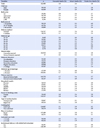




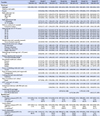
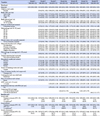
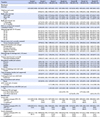
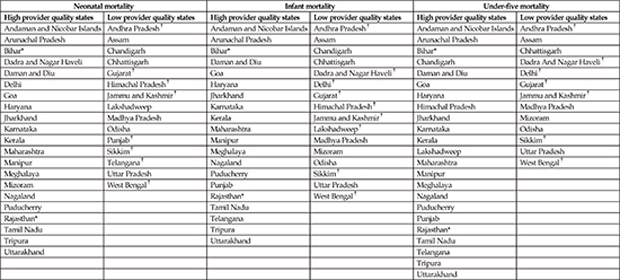

 XML Download
XML Download